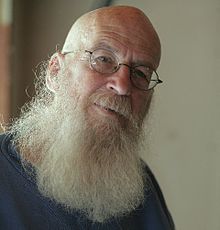Nick Herbert (physicist)
| Nick Herbert | |
|---|---|
 |
|
| Born |
September 7, 1936 Pittsburgh, PA |
| Residence | United States |
| Citizenship | United States |
| Alma mater | Saint Charles Preparatory School, Ohio State University, Stanford University |
| Spouse(s) | Betsy Rose Rasumny (deceased 2002) |
Nick Herbert (born September 7, 1936) is an American physicist and author, best known for his book Quantum Reality.
Herbert studied Engineering Physics at the Ohio State University, graduating in 1959. He received a Ph.D. in physics from Stanford University in 1967 for work on nuclear scattering experiments. After a one-year teaching job at Monmouth College in Illinois, Herbert held a number of posts in industry. The most illustrious of these was senior physicist at Memorex Corporation in Santa Clara, California, where he developed new magnetic materials, as well as magnetic, electrostatic and optical measuring devices, and carried out theoretical work on Lorentz microscopy. He was also senior physicist at Smith-Corona Marchant Corporation in Palo Alto, California where he developed a new theory of xerographic process and worked on early developments in ink jet printing.
While employed in industry, Herbert was part of the Fundamental Fysiks Group at Lawrence Berkeley National Laboratory, founded in May 1975 by Elizabeth Rauscher and George Weissmann. The group's initial interest was in the interpretation of quantum mechanics, the EPR paradox, and Bell's inequality, but members pursued diverse interests that lay outside of mainstream physics, exploring psychedelic drugs, psi phenomena, the nature of consciousness, and speculative connections of these areas with quantum physics. During the 1970s and 1980s, Herbert and Saul-Paul Sirag organized a yearly Esalen Seminar on the Nature of Reality, bringing together participants to discuss the interpretation of quantum mechanics. With Richard Shoup of Xerox PARC, Herbert constructed a "Metaphase Typewriter", a "quantum operated" device whose purpose was "to communicate with disembodied spirits". Despite many tests, including an attempt to contact the spirit of Harry Houdini on the hundredth anniversary of his birth, the group reported no success with the device.
...
Wikipedia
